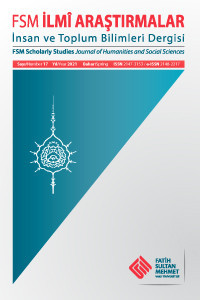Betondan Sûretler: Postkolonyal Dünyanın Mimariyi Yeniden Keşfedişi Üzerine
Bu çalışma postkolonyal dünyanın Batılı mimarlık kuram ve uygulamalarını benimsemesi sürecinde betonarme tekniğinin önemini vurgulamayı amaçlamaktadır. Bu doğrultuda, Batılı mimarlık düşüncesinde çok önemli bir yere sahip olan “bir fikri biçimde taklit etme” (imitation) kavramının bu plastik yapı malzemesi sayesinde adım adım postkolonyal söylem ve uygulamalarına nasıl sirayet etmiş olduğu gösterilmeye çalışılmıştır. Yazıda, bazı örnekler üzerinden postkolonyal dünyanın mimarlarının en çok Auguste Perret’nin taklit anlayışını benimsemiş oldukları gösterilmeye çalışılmıştır. Perret’nin geleneği betonarme vasıtasıyla çağdaşlaştırarak sürdürme amacıyla tercih ettiği tektonik ifadeyi taklit etme anlayışı, bu dünyanın mimarlarına kolonyal çağın hem öncesinde hem de kendisinde meydana getirilmiş olan mimari kültürü, kendilerine has bir Klasizm yerine koymayı mümkün kılmış olduğu açıklanmaya çalışılmıştır. Bu noktayı anlatabilmek amacıyla, Türkiye, Malezya, Hindistan, Sri Lanka ve Singapor gibi ülkelerden seçilmiş bazı önde gelen mimarların eserleri üzerinde bazı mülahazalarda bulunulmuştur. Postkolonyal dünyanın mimarisini temsil etmeleri açısından farklı ülkelerden seçilmiş bu örnekler her milletin kendine has kabul edilen tektonik kültürün yorumlanması esnasında Batılı mimarlık düşüncesinin uyarlanmasında betonarme tekniğinin ne kadar işlevsel olduğunu göstermiş olduğu gibi, Batılı güçlerin hâkimiyeti altında pasiflik içerisinde geçen on yıllardan sonra, bu dünyada aktif bir mimari kültürünün yeniden oluşmaya başladığını da ortaya koymuştur. Sonuç olarak, Postmodernizm’in dünya çapında bir tabanı olmasını mümkün kılmış olan bu “yeniden canlanmış” mimari kültürün günümüz itibarıyla köklerinden güç devşirmeyi bir kenara bıraktığı ve zayıfladığı iddia edilmiştir.
Anahtar Kelimeler:
Postkolonyal mimari, betonarme, Güneydoğu Asya, S. H. Eldem, Geoffrey Bawa, Minette De Silva, Balkrishna Doshi
Concrete Imitations: The Reinstitution of Architectural Culture in the Post-Colonial World
This study aims to underline the importance of reinforced concrete techniques for appropriating Western architectural theories and practices in the post-colonial world. It argues that a firmly based notion in Western architectural thought, imitation, infiltrated step by step into the discourses and practices of the post-colonial world with the help of this plastic material. This article tries to show with examples that the post-colonial architects mainly adopted Auguste Perret’s understanding of imitation as tectonic expression, allowing them to substitute both their pre-colonial and colonial architectural patrimony for a classical tradition that Perret intended to modernize and continue with concrete. To demonstrate the point of this study, a few selected examples were discussed from the works of prominent architects in Turkey, Malaysia, India, Sri Lanka, and Singapore. It is argued that the samples chosen from different countries to represent the architecture of the post-colonial world prove that the reinforced concrete structure was instrumental for architects to appropriate Western architectural theories and practices. At the same time, it also allowed them to reinterpret the relevant tectonic culture in their home countries, with which they reinstituted the architectural culture after many decades that passed passively under the hegemony of Western powers. Finally, it is claimed that the architectural culture “resurrected” as such, which facilitated Postmodernism’s global basis, has given up getting strength from its roots and therefore weakened considerably today.
Keywords:
Post-colonial architecture, reinforced concrete, Southeast Asia, S. H. Eldem, Geoffrey Bawa, Minette De Silva, Balkrishna Doshi Postkolonyal mimari, betonarme, Güneydoğu Asya, S. H. Eldem, Geoffrey Bawa, Minette De Silva, Balkrishna Doshi,
- ISSN: 2147-3153
- Başlangıç: 2012
- Yayıncı: Fatih Sultan Mehmet Vakıf Üniversitesi
Sayıdaki Diğer Makaleler
TSMK H. 2248 Envanterli Albümün Tezhip Tasarımının Mukayeseli Analizi
Pasifist Bir Ülkede Terörle Mücadele: Japonya Örneği
Fransa, Bretön Ulusal Hareketi ve CELIB
XIX. Yüzyılda Osmanlı Toplumunda Aşiretler ve Hukuk: Urfa Örneği
Menâúıb-ı èAli Es-Semarúandì’de -mIş eki
Erdem Dönmez, Arzu ve Tereddüt: 19. Yüzyıl Türk Romanında Muhafazakârlık
